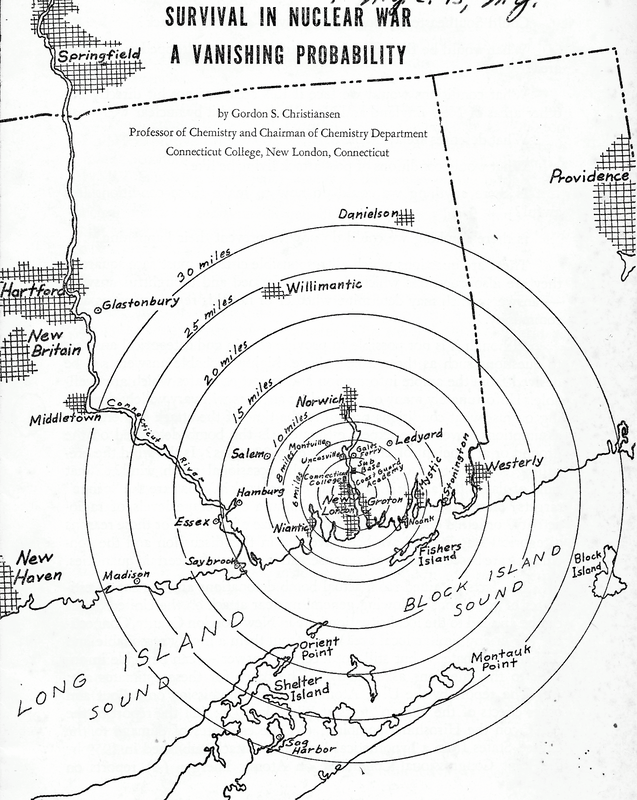|
“Could Southeastern Connecticut survive a nuclear attack? What would be the effects of an atomic weapon dropped within this area? What conditions would we face if this area was not hit directly but other areas of New England and New York were hit by nuclear weapons? What defenses are available to us? What would conditions of post-attack living be like? Is there anything we could do now to prevent their happening?” These are the opening lines to Dr. Gordon S. Christiansen’s 1960 pamphlet “Survival in Nuclear War: A Vanishing Probability.” As the chair of the chemistry department at Connecticut College and active participant in the Committee for Nonviolent Action, Dr. Christiansen volunteered much of his time and energy to educate the public about the power of nuclear weapons, the horrific effects of nuclear fallout, and the ultimately suicidal nature of the arms race and MAD (mutually assured destruction). In the pamphlet, Dr. Christiansen addresses all of these questions, the answers for which mostly have not changed in the ensuing decades. Some answers remain the same because there have been only a few major advances in nuclear weapons technology since the 1960s. On the other hand, other answers remain unchanged because of the lack of advances in handling the unavoidable radioactive fallout. In fact, in some cases, a nuclear detonation in a heavily populated area today could be worse than such a detonation in 1960 simply because of how much more reliant we now are on technology and a globalized economy. Here, we present Dr. Christiansen’s 15-page pamphlet in its entirety. For any Connecticut residents who have ever felt anxious about living so close to the US Navy sub base, or for the morbidly curious who have ever wondered what a nuclear detonation might look like in New England: this is a must-read. (Click the image below to download the PDF version of the original pamphlet) — Take Action The CT Committee for the Prohibition of Nuclear Weapons organizes pro-disarmament demonstrations throughout the year. To participate in these demonstrations against nuclear arms and in support of the UN’s Treaty on the Prohibition of Nuclear Weapons, please get in touch with us on Facebook at facebook.com/voluntownpeacetrust or email us at [email protected]. — Support Us If you like our weekly posts, please consider supporting this project with a one-time or recurring donation. Contributions of all sizes are appreciated. Click this link to learn more about what we do and how you can donate: https://www.mightycause.com/organization/Voluntown-Peace-Trust — Source Christiansen, Gordon S. Survival in Nuclear War: A Vanishing Probability. Connecticut College, 1961. -- Further Resources Berrigan, Frida. “On Friday, ‘Say no to nuclear weapons.’” The Day. 1 August 2021 [Accessed 4 August 2021]. https://www.theday.com/article/20210801/OP03/210809975 “Electric Boat History.” General Dynamics: Electric Boat. [Accessed 4 August 2021]. http://www.gdeb.com/about/history/ “Nuclear Weapons: Who Has What at a Glance.” Arms Control Association. August 2020 [Accessed 4 August 2021]. https://www.armscontrol.org/factsheets/Nuclearweaponswhohaswhat “Treaty on the prohibition of nuclear weapons.” United Nations: Office of Disarmament Affairs. [Accessed 4 August 2021]. https://www.un.org/disarmament/wmd/nuclear/tpnw/ Wellerstein, Alex. “Nukemap.” Nuclear Secrecy. [Accessed 4 August 2021]. https://nuclearsecrecy.com/nukemap/ “What if We Nuke a City?” Kurzgesagt — In a Nutshell. 13 October 2019 [Accessed 4 August 2021]. https://www.youtube.com/watch?v=5iPH-br_eJQ Comments are closed.
|
AuthorWrite something about yourself. No need to be fancy, just an overview. Archives
March 2023
Categories |


 RSS Feed
RSS Feed